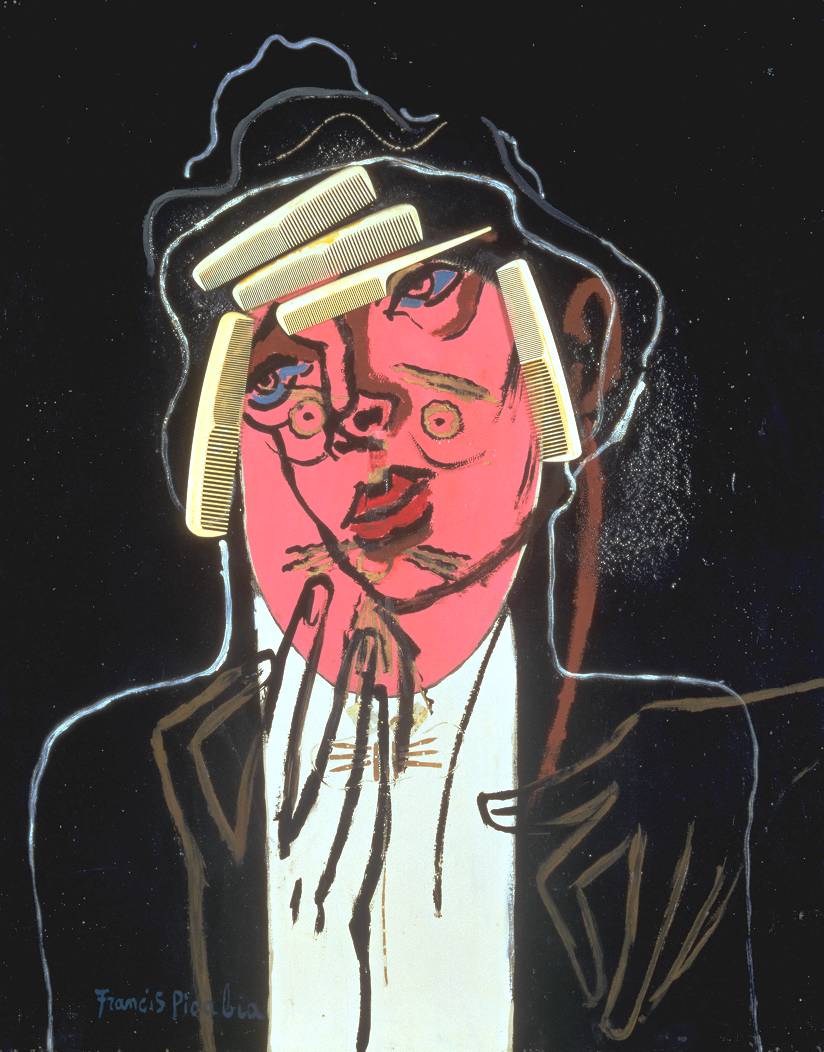Francis Picabia
The Handsome Pork Butcher

Francis Picabia, The Handsome Pork Butcher circa 1924-6, circa 1929-35 © ADAGP, Paris and DACS, London 2002
Orientation
At first sight this work is hard to read, which reflects its complex history. It originally portrayed a man in a dinner jacket, seen from the chest up and set against a solid black background. Some years later, Picabia reworked it and painted a woman’s face over the top of the man’s. The result is a predominantly black painting with a large, bilious pink oval in the centre, which represents the man’s head. Below the head is a white, rectangular block leading down to the bottom edge of the canvas. This is the man’s shirtfront. Surrounding and over the top of these two blocks of colour is a tangle of roughly painted lines which make up the woman’s face, hair and hands. Her face completely overlaps that of the man, and the result is slightly confusing. But her eyes are emphasised by splashes of bright blue, and her lips with bright red, and this rather overstated make-up helps us to make sense of the lines that form her face.
Finally, surrounding the top of the pink oval face are five plastic combs, which have been stuck onto the canvas. One is on either side of the man’s face and three are placed above each other on the top of his head. The surface of the canvas is glossy but wrinkly in places and across the pink face the surface is scored and uneven. The overall effect is disorientating and the livid colours set in an expanse of black have the effect of making the painting appear simultaneously austere and garish.
Artist Background
Francis Picabia was a French artist who had a formal art training. He was very influenced by the work of Fauvist artists such as Matisse and Derain who used vivid colour for its own sake and to create a sense of energy, rather than for symbolic effect or to imitate nature. He was also influenced by Cubism and by 1912 Picabia’s work combined Fauvist colour with Cubist abstraction. Like the Cubists, he also embraced the creative potential of collage. In Picabia’s case, he used everyday materials to help create satirical works that mocked both traditional conventions of painting and the society that supported them.
He was part of an avant-garde circle of artists and writers that included the Surrealist poet and critic Guillaume Apollinaire and the artist Marcel Duchamp. Duchamp and Picabia were friends and are closely associated with the development of both Dada and Surrealism. Dada was an artistic reaction of disgust towards the horrors of the First World War and the social classes who had instigated and supported the war. It encompassed all the arts and manifested itself across Europe with powerful centres in Zurich and Berlin. A principal format for Dada was vicious satire and nonsense. Dada art lampooned not just traditional authority figures, but also their moral codes and cultural values. Dada saw these values as utterly discredited and fraudulent, having been used to justify the slaughter of World War I. For many years, The Handsome Pork Butcher was considered to be from Picabia’s Dada period, which was roughly 1915-1921. However it is now thought to have been started after 1921 when Picabia turned his back on Dada, believing the movement to be exhausted.






